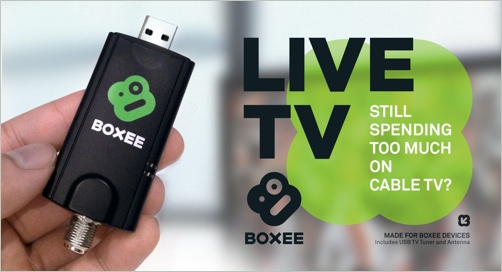-
Boxee Aggressively Pursues Cord-Cutters With New Live TV Dongle
Connected device maker Boxee is aggressively going after pay-TV cord-cutters with a new Live TV dongle it is introducing this morning. The dongle plugs into a USB slot on the Boxee box and takes in a feed of live broadcast channels accessed from either an HD antenna or via a pay-TV provider (note there's always a tier of local broadcast channels available without a set-top box, however the number and quality varies widely). Boxee's CEO Avner Ronen walked me through the logic of who it is appealing to as well as the key challenges for success.
Boxee's argument here is that for many people the combination of low-cost or free over-the-top "OTT" sources (e.g. Netflix, Hulu, YouTube, etc.) and programming that's available for free on broadcast networks is not only a strong value on its own, but when compared to the high-cost of pay-TV services, is a compelling alternative. Avner notes that especially for "cord-nevers" - primarily younger people who live their lives online and often have limited financial resources - the affordable OTT/broadcast package is more aligned with their interests. Underlying this is that 89 of the top 100 most-watched TV shows are on broadcast networks - things like the Super Bowl, the World Series, the Oscars, etc. Especially when combined with a subscription to Hulu Plus or Netflix, it's very plausible that many people would still feel pretty well-served even without pay-TV's full lineup of channels.
The live TV dongle also creates another benefit which is an "all-in-one" solution. No more switching inputs or explaining how to do so to less tech-savvy family members (remember, complexity is a key hurdle for anyone considering cutting the cord). With Boxee and the live TV dongle, you can seamlessly move back and forth between OTT and broadcast programming. In fact, with Boxee's UI and social features, it's arguably a superior experience to today's typical set-top box.
However, there are important limitations to Boxee plus the dongle, including:
Losing sports that are only on cable networks - If you're more than a casual sports fan, it would be unthinkable to give up pay-TV. While it's true, for example, that the World Series is on broadcast TV, most of the playoffs are on cable only. Then there are all the home town sports carried on regional sports networks. Still, as I pointed out earlier this year, non-sports fans could be paying at least $3 billion per year to subsidize the insanely high cost of sports programming. Boxee allows entertainment-oriented viewers a viable way to opt out.
Broadcast channel quality will vary widely - As mentioned above, though pay-TV providers deliver broadcast channels in the clear, their quality is all over the board. Avner explains that he gets HD feeds from both Cablevision and Time Warner Cable that are actually better than what's delivered to the set-top box due to compression. However, I've tried this route with Comcast and get the broadcast channels only in standard definition, which look really crummy on a nice HD TV. Yes, you can buy an HD antenna, but results there too will vary. In the HD age, SD will feel like a step backwards.
Relatively high cost of the Boxee box - Though the concept is supposed to appeal to the cost-conscious, asking prospects to pay $179 for the Boxee box and then another $49 for the dongle is a high hurdle to get over, despite the quick payback from cutting the cord. Avner acknowledges the price is too high, especially given alternatives like Roku's entry-level $50 player, but until Boxee switches its core processor, there's not much room to lower its price. This will be a deterrent to many prospects.
Breaking the pay-TV "triple-play" bundle eliminates the discount - Cable and telco operators have cleverly packaged video, broadband and voice services into a "triple-play" bundle offered at a discounted price. Drop video and what you'll pay for broadband and voice will go up, which means you don't get to bank quite as much savings as you thought. The equation will still work for many, but won't be quite as compelling.
Market education, inertia and the nice-to-haves - Even though the cord-cutting theme has been floating for a while now, the fact is it takes a lot of market education to incent significant change in consumer behavior. Avner agrees that a small company like Boxee itself can't drive this; other larger companies with their own devices need to advocate for cord-cutting as well. To date we haven't seen this, even from Google TV, which would be a logical candidate. Then there are the little nice-to-haves that go missing with the Boxee OTT/dongle approach that will cause further hesitancy. Tops on the list is DVR capability which now has 40% penetration in the U.S. Boxee could add a DVR too in the future, but that would likely mean another external add-on purchase, which would suppress interest.
When all the pros and cons are added up, there's no question that Boxee's OTT/broadcast approach is going to find some fans, especially among the cost-conscious. However, it's not quite the perfect solution that many cord-cutting enthusiasts envision. Still, Boxee is fundamentally correct that viewing behaviors are changing, especially among certain segments of viewers, and that conventional TV models have serious flaws - all reasons why pay-TV operators should be rolling out TV Everywhere as fast as possible. Changing the status quo is going to play out in the very long-term. Boxee will be playing an important role, but others are going to have to be equally aggressive.
Categories: Cable TV Operators, Devices, Satellite, Telcos
Topics: Boxee


